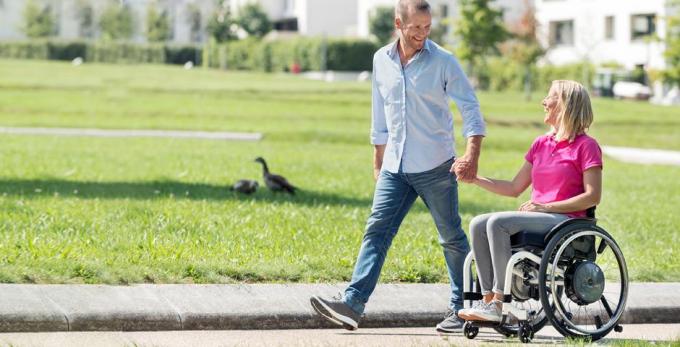
A power assist device is a motorised accessory that can be attached to a manual wheelchair. It allows a wheelchair user to propel with less energy expenditure. The motor in the power assist device helps with wheelchair propulsion, reducing the physical strain on the wheelchair user and often extending their ability to get around in their wheelchair.
For many who have taken the leap, their power assist device has become part of their everyday routine, offering independence through discreet motorised assistance throughout the day. There are several different types of power assist devices, and all have their own pros and cons. In this blog post, we’ll take a look at the various types of power assist devices and what their benefits include.
Aftermarket Attachments
The Smartdrive MX2+ and Alber Smoov are examples of an aftermarket attachment power assist device. These devices fit onto the rear of the manual wheelchair, either onto the camber tube itself or a removable bracket for folding wheelchairs.
Aftermarket attachments are easy to start through one push or pressing a switch/button, and then you steer the wheelchair as usual through the wheelchair wheels. This style of power assist devices is often easy to put on and remove from the wheelchair, as the size and weight are manageable for most people.
As aftermarket attachments do require the user to steer the manual wheelchair through the wheels and have good reaction times to manually turn off the power assist when needed, they’re not always suitable for everyone. They also don’t provide braking assistance, so they don’t slow you down when going downhill or on ramps, and you need to turn the device off and then manually slow down and ‘brake’ just as you would when manually propelling a wheelchair.
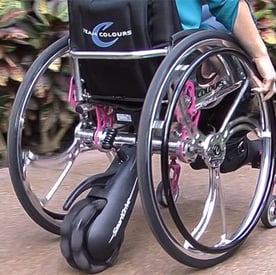
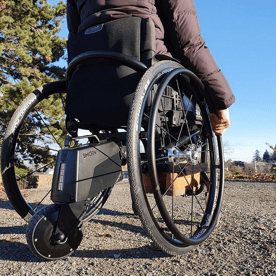
Pushrim Activated Wheel Assemblies
The Alber Twion, Alber E-motion and Quickie Xtender are examples of pushrim activated wheel assemblies. With this style of power assist, the standard manual wheelchair wheels are replaced with wheels that have inbuilt motors and sensors attached to the handrims. The handrim sensors interpret the force input during propulsion and turns that force into momentum through the wheels. Pushrim activated wheel assemblies can provide forward propulsion as well as braking assistance, so the power assist can also help slow the wheelchair down and stop as needed. Most pushrim activated wheel assemblies also have wheels which can be programmed individually, so if a person has one upper limb that is weaker than the other the programming can be adjusted to compensate for this.
Pushrim activated wheel assemblies can be very successful for people who require both forward and braking assistance, or who have reduced upper limb strength on one or both sides where the ability to propel a manual wheelchair is significantly reduced.
The powered wheels can be heavy to put on and remove compared to an aftermarket attachment, as each wheel usually weighs more than 6kg. As the handrims often contain sensors, the sensors can be prone to damage if knocked or dropped. A user must take care to ensure the wheels are not dropped or stored with pressure on the handrims, or the handrims bumped on doorways.
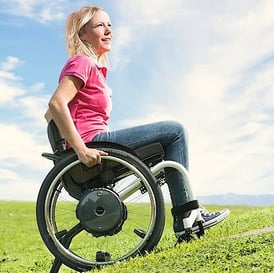
Wheelchair Power Drives
Wheelchair power drives are power assist devices with a joystick, where the wheelchair is then controlled with the joystick. The Quickie iXpress and Alber E-Fix are examples of wheelchair power drives, and these devices have powered wheels attached to a battery and joystick. Like pushrim activated wheel assemblies, the standard wheels on a wheelchair are replaced with powered wheels. The wheelchair, including propulsion and steering, is fully controlled via the wheelchair joystick. The joystick can be positioned for the wheelchair user to control, or at the rear of the wheelchair for attendant control. The power assist device can also be disengaged so the wheelchair wheels can be manually pushed as required.
Wheelchair power drives can work well for people or their carers who find manually propelling a wheelchair very difficult or fatiguing when using their wheelchair for longer distances. Because only hand control is needed to operate the joystick, people with limited movement may be able to use one successfully. They can be a good alternative to a power wheelchair when a power wheelchair is not suitable for the home environment or available transport, however they do not provide the performance or ride quality (suspension) that most power wheelchairs offer.
Wheelchair power drives can be heavy and difficult to put on and remove from a manual wheelchair, so if you are transferring the wheelchair in/out of a vehicle several times a day it may not be the best option. The powered wheels themselves tend to be heavy and need disconnecting from the joystick before being able to be removed.
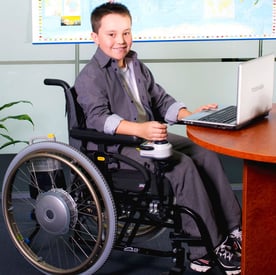
Trike Style
The Klaxon Klick and Triride are examples of trike style power assist devices. These power assists fit onto the front of a wheelchair and provides handlebars with controls. The power assist device lifts the front castors off the ground, so that the wheelchair contacts the ground through the rear wheels and the front trike wheel. Because of this, trike style power assist devices are great for outdoor mobility as the larger wheels remove the risk of the front castors getting caught on obstacles, and the motor offers more torque and power for speed and traversing over terrain. As trike style power assist devices significantly increase the length of a wheelchair, they are often too large to be used in many indoor environments.
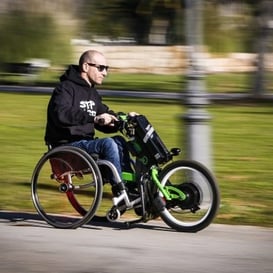
Besides the different types of power assist devices, there are some things you should consider for all types of power assist devices:
- Is your current wheelchair suitable for mounting a power assist device? Power assist options place a lot more force and velocity on the frame, and the castor housing in particular. It is best to discuss with your wheelchair supplier as different wheelchair brands have their own best practice guidelines for attaching power assist devices.
- What style of chair will best match the power assist option that best meets your needs?
- How much rear wheel axle positioning do you need in your frame, and do you need to alter your centre of gravity? As the power assist device engages with the initial push, for some wheelchair users this may require them to move the centre of gravity to a more stable position to maintain their balance and stability in the wheelchair.
- How will you store the power assist device, including the practical removal of the device? As discussed above, the weight of devices varies along with the maintenance and charging procedures
- Will you be using the device on multiple wheelchairs and what additional brackets/attachments do you need? If so, some power assist options are easier to transfer than others.
For more information on what the clinical evidence says about power assist devices, visit our blog at https://blog.gtk.com.au/power-assist-devices-what-does-the-evidence-say
You can see GTK’s range of power assist devices here, and our consultants enjoy helping each individual person find out what type of power assist is for them. We can also help determine whether a wheelchair is suitable for mounting a power assist device. Contact us today to see how we can help.


